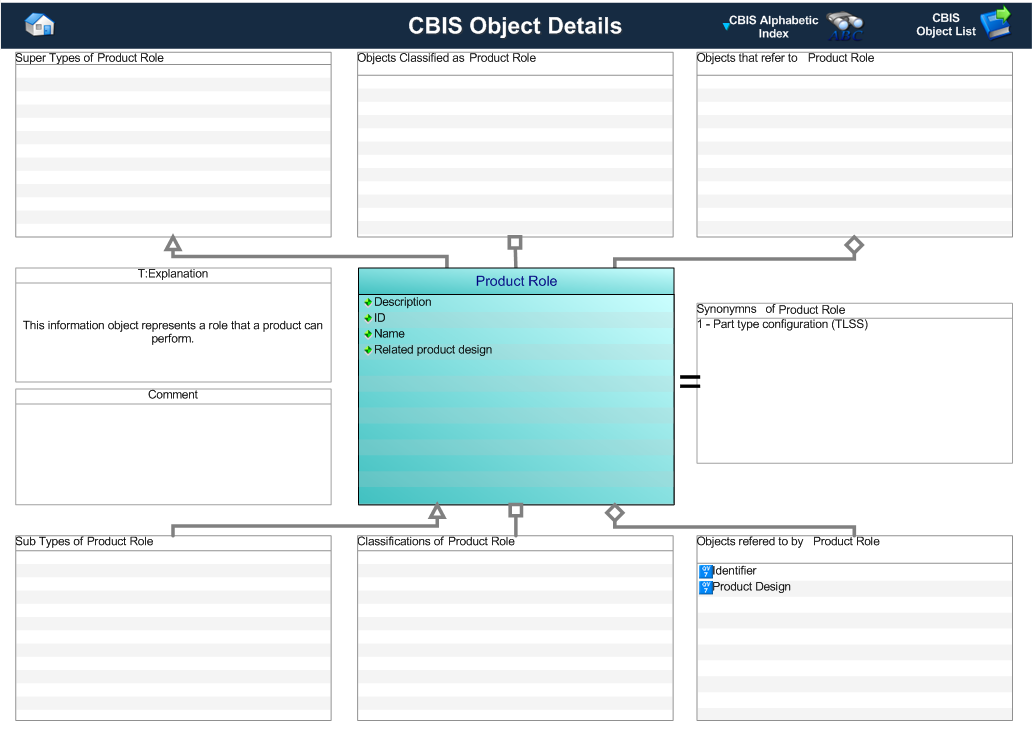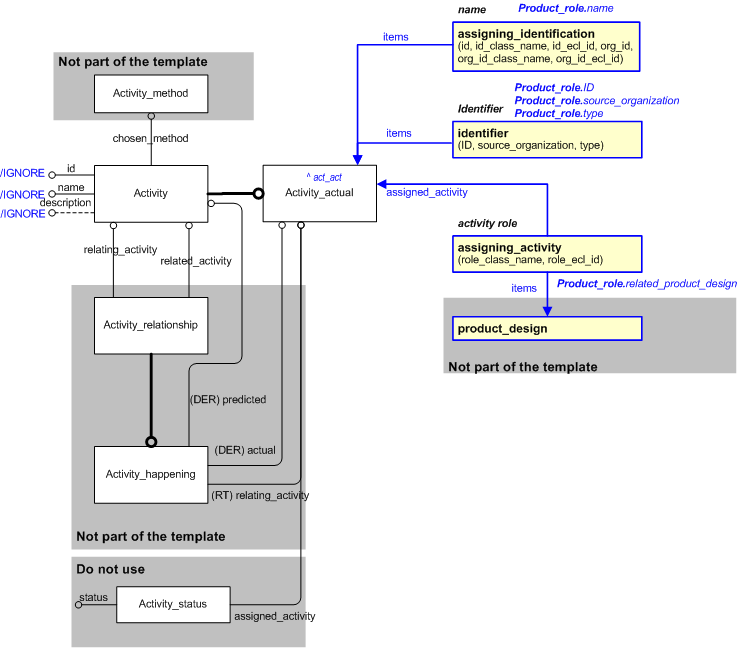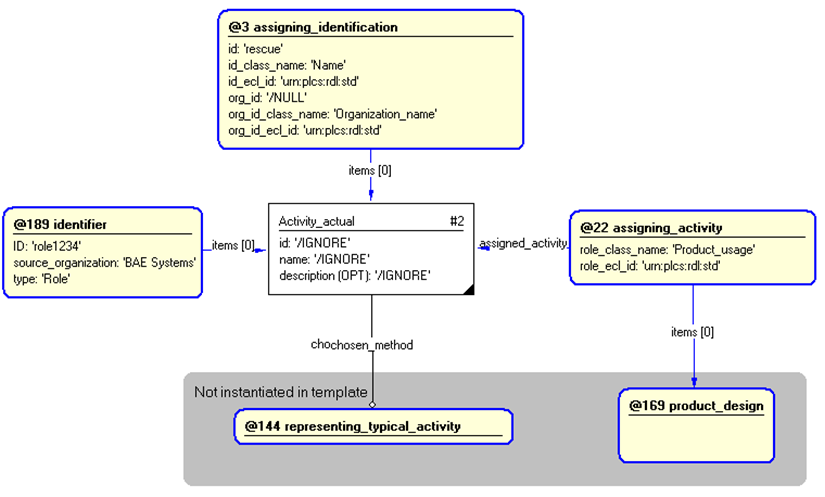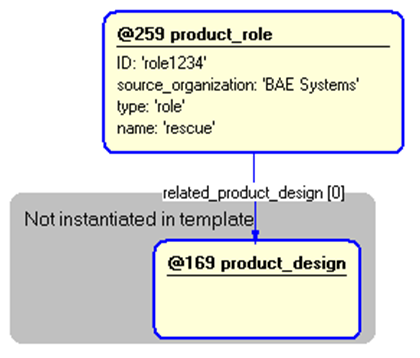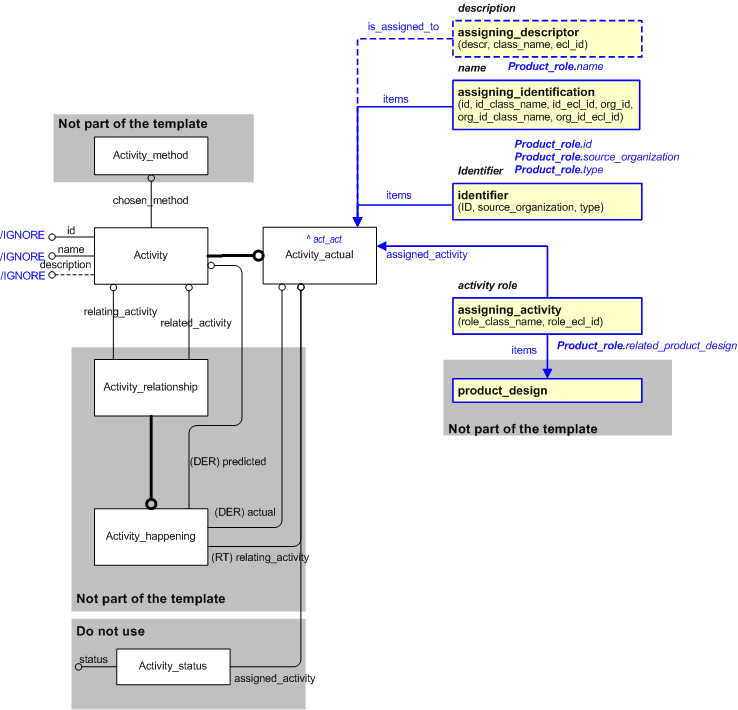Template:— product_role (prod_role)
Context:— UK_Defence |
Date: 2009/04/17 11:04:01
Revision: 1.2
|
This section specifies the template product_role.
NOTE
The template has been defined in the context of
UK_Defence.
Refer to the business context for details of related templates.
NOTE
An explanation of a template and the associated instantiation path is
provided in the
Template overview
section.
This template describes how to represent a UK_Defence product role, using
Activity_actual.
This information object represents a role that a product can perform
For further information about the representation of a product role, see below.
This information object represents a role that a product can perform.
Figure 1 — Graphical Representation for Business Object Product Role
Record:
This information object represents a role that a product can perform.
|
Attribute name
|
Attribute description
|
Attribute type
|
Optionality
|
| Description |
This is the description of the product role. |
Intrinsic |
Optional |
| ID |
This is the identifier of the product role. |
Identifier |
Mandatory |
| Name |
This is the name of the product role.
EXAMPLE: transporting, bombing, training, refueling, rescue, reconnaissance,
transported, storage, test.
|
intrinsic |
Mandatory |
| Related Product Design |
This is the reference to the product design for which the product role is defined. |
Product Design |
Mandatory |
Table 1 — Product attribute details
The EXPRESS-G diagram in
Figure
2
shows the templates and EXPRESS entities that are required
to represent the template
"product_role".
The text highlighted in blue shows the template parameters.
Figure 2 — An EXPRESS-G representation of the Information model for product_role
The graphic for the template to be used in other EXPRESS-G diagrams
is shown in Figure
3
below.
Figure 3 — The graphical representation of the product_role template
The following input parameters are defined for this template:
The identifier of the product role.
The organization that created the associated identifier. Additionally
a Person or Information System could be defined when either of these are the source; see Identifier template characterizations
This is the name of the type of the class used to classify the identifier and so
provide the role or reason for the identification.
The following classes and their sub-classes can be used:
The name of the product role.
The following reference parameters are defined for this template:
Allow the
Activity_actual
entity instantiated in this path to be referenced when this template is used.
%^target = $product_role.act_act%
Allows referencing of entity Activity_actual from outside the template, e.g.
in order to characterize the Activity_actual further.
The following parameter combinations specify a uniqueness constraint:
Unique constraint: Unique product_role
Each instance of the
entity
(
Activity_actual)
within the data set shall be uniquely identified
by a combination of the following parameters on this
template (product_role) namely:
related_product_design,
ID,
name.
The
instance is
referenced by the following template parameter:
act_act.
The product role should only occur once in a data set.
The instantiation path shown below specifies the entities that are to be
instantiated by the template.
A description of templates and the syntax for the instantiation path is
provided in the
Templates Help/Information section.
-- instantiate Activity_actual Activity_actual%^act_act =
Activity_actual%
^act_act.id = '/IGNORE'
^act_act.name = '/IGNORE'
^act_act.description = '/IGNORE'
^act_act.chosen_method = '/IGNORE'
-- assigning activity_actual to the corresponding product in a specific role /
assigning_activity(
role_class_name= 'Product_usage' role_ecl_id= 'urn:plcs:rdl:std',
assigned_activity= ^act_act,
items=@related_product_design)/
-- assign product role's name to activity_actual /
assigning_identification(
id=@name,
id_class_name='Name',
id_ecl_id=''urn:plcs:rdl:std',
org_id='/NULL',
org_id_class_name='Organization_name',
org_id_ecl_id='urn:plcs:rdl:std',
items=^act_act)/
-- assign product role's identifier to activity_actual /
identifier(
ID=@ID,
source_organization=@source_organization,
type=@type,
items=^act_act)/
The following entities are instantiated with attributes as specified:
The instance diagram in Figure
4
shows an example of the EXPRESS entities and templates that are instantiated by the template:
/product_role(ID='role1234', source_organization='BAE Systems', type='Role', name='rescue', related_product_design='@169')/
(an illustration of the consolidated product_role template is shown in
Figure
5 below.)
Figure 4 — Entities instantiated by product_role template
The instance diagram in
Figure
5
shows the graphic symbol for the template that is to be
used in other instance diagrams. The example template is:
/product_role(ID='role1234', source_organization='BAE Systems', type='Role', name='rescue', related_product_design='@169')/
Figure 5 — Instantiation of product_role template
The following section details how the
product_role
template can be optionally characterized by assigning
other constructs to it. These are characterizations commonly
applied to the template. The ISO 10303-239 EXPRESS model may enable
other assignments to the entities instantiated by the template.
The EXPRESS-G diagram in Figure
6
shows the possible characterizations of the template
"product_role".
Figure 6 — Characterizations for product_role
The following characterizations may apply:
Characterization Assigning description
NOTE this characterization is optional.
The description of the role can be
represented by assigning a descriptor
using the assigning_descriptor
template.
/assigning_descriptor(descr='Sea resuce role', class_name='Description', ecl_id='urn:plcs:rdl:std', is_assigned_to='@259')/
